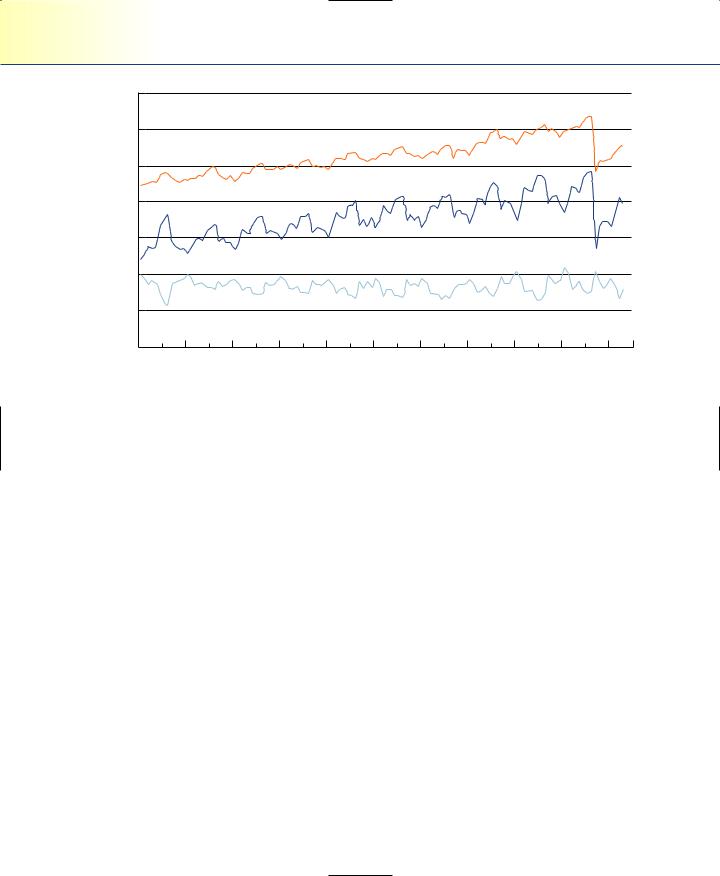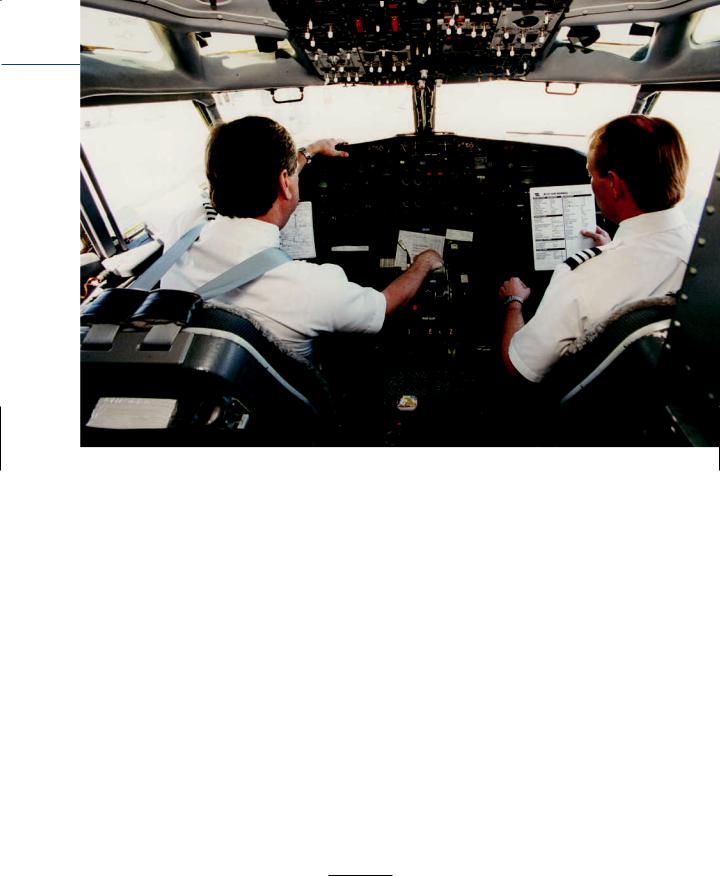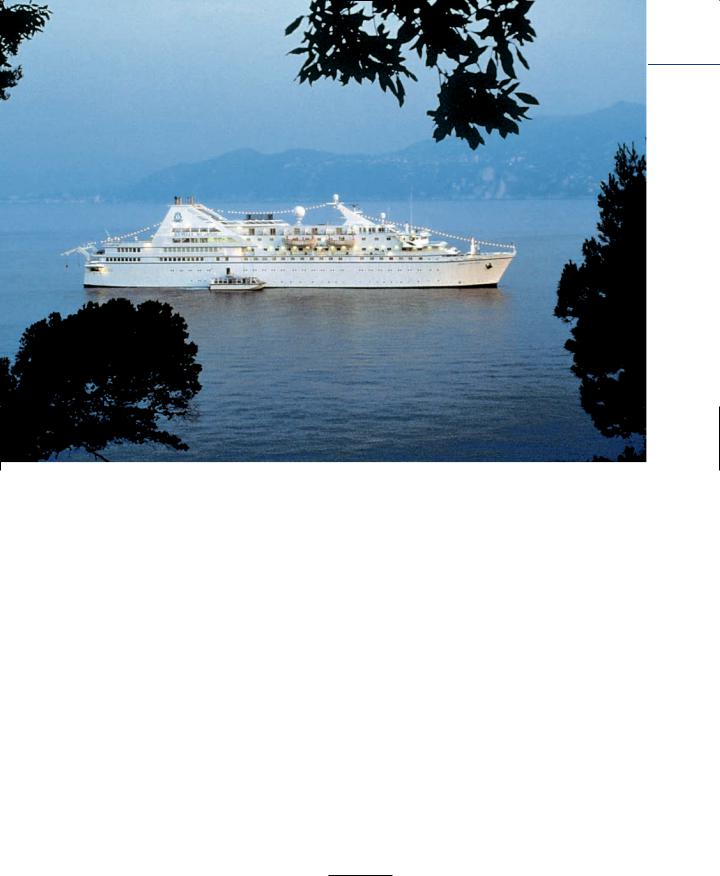
- •CONTENTS
- •PREFACE
- •Content—Benefits for Students
- •Content—Benefits for Instructors
- •Features of the Book for Students and Instructors
- •Supplementary Materials
- •Acknowledgments
- •What Is Hospitality Management?
- •The Manager’s Role in the Hospitality Industry
- •Why Study in a Hospitality Management Program?
- •Planning a Career
- •Employment as an Important Part of Your Education
- •Getting a Job
- •Employment at Graduation
- •The Outlook for Hospitality
- •Summary
- •Managing Change
- •Demand
- •Supply
- •Workforce Diversity
- •The Impact of Labor Scarcity
- •Summary
- •The Varied Field of Food Service
- •The Restaurant Business
- •The Dining Market and the Eating Market
- •Contemporary Popular-Priced Restaurants
- •Restaurants as Part of a Larger Business
- •Summary
- •Restaurant Operations
- •Making a Profit in Food Service Operations
- •Life in the Restaurant Business
- •Summary
- •Chain Restaurant Systems
- •Independent Restaurants
- •Franchised Restaurants
- •Summary
- •Competitive Conditions in Food Service
- •The Marketing Mix
- •Competition with Other Industries
- •Summary
- •Self-Operated Facilities
- •Managed-Services Companies
- •Business and Industry Food Service
- •College and University Food Service
- •Health Care Food Service
- •School and Community Food Service
- •Other Segments
- •Vending
- •Summary
- •Consumer Concerns
- •Food Service and the Environment
- •Technology
- •Summary
- •The Evolution of Lodging
- •Classifications of Hotel Properties
- •Types of Travelers
- •Anticipating Guest Needs in Providing Hospitality Service
- •Service, Service, Service
- •Summary
- •Major Functional Departments
- •The Rooms Side of the House
- •Hotel Food and Beverage Operations
- •Staff and Support Departments
- •Income and Expense Patterns and Control
- •Entry Ports and Careers
- •Summary
- •The Economics of the Hotel Business
- •Dimensions of the Hotel Investment Decision
- •Summary
- •The Conditions of Competition
- •The Marketing Mix in Lodging
- •Product in a Segmented Market
- •Price and Pricing Tactics
- •Place—and Places
- •Promotion: Marketing Communication
- •Summary
- •The Importance of Tourism
- •Travel Trends
- •The Economic Significance of Tourism
- •The United States as an International Tourist Attraction
- •Businesses Serving the Traveler
- •Noneconomic Effects of Tourism
- •Summary
- •Motives and Destinations
- •Mass-Market Tourism
- •Planned Play Environments
- •Casinos and Gaming
- •Urban Entertainment Centers
- •Temporary Attractions: Fairs and Festivals
- •Natural Environments
- •On a Lighter Note. . .
- •Summary
- •Management and Supervision
- •The Economizing Society
- •The Managerial Revolution
- •Management: A Dynamic Force in a Changing Industry
- •What Is Management?
- •Summary
- •Why Study Planning?
- •Planning in Organizations
- •Goal Setting
- •Planning in Operations
- •The Individual Worker as Planner
- •Long-Range Planning Tools
- •Summary
- •Authority: The Cement of Organizations
- •Departmentalization
- •Line and Staff
- •Issues in Organizing
- •Summary
- •Issues in Human-Resources Management
- •Fitting People to Jobs
- •Recruiting
- •Selection and Employment
- •Training
- •Retaining Employees
- •Staff Planning
- •Summary
- •The Importance of Control
- •Control and the “Cybernetic Loop”
- •Tools for Control
- •Summary
- •Leadership as Viewed by Social Scientists
- •Why People Follow
- •Leadership Theories
- •Communication
- •The Elements of Leading and Directing
- •Developing Your Own Leadership Style
- •Summary
- •A Study of Service
- •Rendering Personal Service
- •Managing the Service Transaction
- •How Companies Organize for Service
- •Summary
- •INDEX

Businesses Serving the Traveler |
429 |
destinations, whether it be Disney World, natural attractions such as the Grand Canyon, or urban centers such as New York City and Washington, D.C. International travel is seen less as a venture into the unknown and more as something everybody’s doing.
An important factor in international travel, and in the long-term growth of the United States as a destination, is currency fluctuation. Following World War II, the U.S. dollar was the strongest currency in the world. Other currencies were weak largely because those countries were recovering from war damage. By the 1970s, however, that recovery was complete, and other currencies gained against the dollar. In the 1980s, economic growth in many of these countries accelerated the trend. The cheaper dollar, then, made the United States a travel bargain, and travelers to the United States and travel spending increased dramatically. This factor is a doubleedged sword. When Asian currencies crashed in 1996 and 1997, the visitor flow from those countries to the United States slowed appreciably. More recent fluctuations have had similar effects. Now the U.S. dollar has rebounded slightly after weakening aginst other major currencies.
In the hotel industry, some properties in large cities with large numbers of international tourists attribute one-third or more of their occupancy to visitors from outside the country. Twenty-five percent of international visitors’ budgets goes for lodging. Many hotels, responding to the needs of this market, are anxious to hire multilingual managers, clerks, and service personnel. Some hotels have also begun actively to promote international business through representation at travel trade fairs abroad and through solicitation of international tour business from travel agents. The importance of international visitors to restaurants is suggested by the fact that their second most popular recreation activity (after shopping) was dining and food and beverage purchases. Nineteen percent of international visitors’ expenditures is for food and beverage. Nearly half of international visitors’ spending, then, is accounted for by the hospitality industry.
Businesses Serving the Traveler
PASSENGER TRANSPORTATION
Earlier, we looked at travel trends as a part of tourism. Here, our concern is to see travel as an allied industry that works with hospitality firms in serving travelers. You may recall that growth in travel by air has increased compared to travel by auto or other private vehicle. Bus travel has been increasing, while rail travel has declined. Bus and rail, in any case, account for only a small share of travel. The growth component in com- mon-carrier travel, then, has been air. The growth of the airline industry during the last decade is detailed in Figure 13.6. The figure expresses growth in terms of

430 |
Chapter 13 Tourism: Front and Center |
|
70 |
|
|
|
|
|
|
|
|
|
|
|
|
|
|
|
|
|
|
Available seat miles |
|
||
|
60 |
|
|
|
|
|
|
|
|
|
|
|
50 |
|
|
|
|
|
|
|
|
|
|
Miles |
|
|
|
|
Revenue passenger miles |
|
|
|
|||
40 |
|
|
|
|
|
|
|
|
|
|
|
of |
|
|
|
|
|
|
|
|
|
|
|
|
|
|
|
|
|
|
|
|
|
|
|
Billions |
30 |
|
|
|
|
|
|
|
|
|
|
|
|
|
|
|
|
|
|
Unused seat |
|
||
|
20 |
|
|
|
|
|
|
|
|
|
|
|
10 |
|
|
|
|
|
|
|
|
|
|
|
0 |
|
|
|
|
|
|
|
|
|
|
|
Jan-92 |
Jan-93 |
Jan-94 |
Jan-95 |
Jan-96 |
Jan-97 |
Jan-98 |
Jan-99 |
Jan-00 |
Jan-01 |
Jan-02 |
Figure 13.6
Domestic air seat passenger miles. (Source: U.S. Department of Transportation, Bureau of Transportation Statistics, Transportation Indicators Report, 2005, www.bts.gov/publications/transportation_indicators.)
(1) available seat miles, (2) revenue passenger miles, and (3) unused seat miles. Available seat miles is a measure of capacity, revenue passenger miles is a measure of volume, and unused seat miles is a measure of utilization. Keep in mind, however, that while revenues may be increasing overall, deep dips in airline sales volume can occur. Airlines, like most tourism industries, are very sensitive to the general economic climate.
Trends in Air Travel. The airlines have grown from an oddity in the transportation world of the 1920s, when only the daring flew, to the dominant common carrier worldwide. Following deregulation in 1978, the number of airlines increased dramatically and competition became fierce on most routes. In order to achieve greater economies of scale, large airlines developed the hub-and-spoke system in the early 1980s. In this system, passengers are assembled at a central point—a hub—such as Chicago, New York, or Detroit by smaller aircraft that form commuter airlines. There they board larger aircraft that fly to another hub, from which passengers are distributed to their final destinations by the same feeder system. If large aircraft fly with efficient load levels on high-volume routes, the hub-and-spoke system achieves the advantages of economies of scale.
On the other hand, there are some offsetting disadvantages to hub-and-spoke systems. Because of the complex schedules required to service such a system, traffic

Airlines represent a complex system of transportation, communication, coordination, and customer service. (Courtesy of Southwest Airlines.)
control and weather delays can create serious problems. Delays multiply through the system, increasing costs because of idle aircraft and personnel time—to say nothing of passenger annoyance. Moreover, the large investment in people and equipment at hubs raises the fixed costs for operators using the centralized system.
An alternative to the hub-and-spoke system is the short-haul airline, specializing in point-to-point service. In the mid-1990s, these short-haul airlines became more aggressive in both price and service. Point-to-point carriers manage short aircraft turnarounds, minimize staff, and hold down investment. As a result, they can offer lower fares and more frequent service, generally of the no-frills variety. As the point-to-point system has proved to have real competitive advantages, many of the larger carriers began launching no-frills, short-haul carrier subsidiaries that duplicated the shorter routes, limited service, and lower fares offered by short-haul carriers. One of the first and still most successful airlines using the point-to-point strategy is Southwest Airlines.
Southwest is a notable company for many reasons. Southwest is the sixth largest airline company in the country (by revenues) and the first in terms of “passenger miles.” Its average fare in 2006 was $104.75. It is able to keep fares low because of its focus
431

432Chapter 13 Tourism: Front and Center
on short-haul and high-frequency flights. In addition to using the point-to-point strategy (which has since been adopted by other companies), it is the only major airline company to have made a profit in recent years and, in fact, just recorded its thirty-fourth consecutive year of making a profit. This is quite remarkable given that the airline industry lost $10 billion in 2005. It is particularly notable given the high costs associated with running an airline, which include high capital costs, high labor costs, and the fluctuation (and high expense) of fuel. Finally, another differentiating factor is its booking model—the majority of fares are booked directly though the company and 73 percent of the company’s revenue is booked through their Web site.
The Airline Industry. Several factors have affected the way in which business is conducted in the airline industry. One of the most significant was deregulation of the industry, which took place in 1978. It had the effect of lowering costs and allowing more carriers into the market. Deregulation also had the effect of encouraging greater price competition. There are literally hundreds of thousands of special fares—many available only for a short period of time, ranging from a few minutes to a few days. (Special fares generally appear on the computer network used by airlines and travel agents and can be discontinued at will by the carrier.) Almost all of these special fares are discounted fares, and the impact of discounting has been to hold down the cost of travel for cost-sensitive travelers. Most special fares, however, are structured so that they will not be attractive to the business traveler. Many, for instance, require travelers to stay over a Saturday night, a night when most business travelers would rather be home with their families. The effect of discounted fares has been to keep personal travel costs down while business travel costs rise. As a result, the volume of personal travel has been more buoyant than business travel.
Another significant development in air travel has been the growth of partnerships between airlines, generally airlines with noncompetitive route structures. These partnerships offer advantages to both customer and airline through the practice known as code sharing, whereby airlines share marketing and operating expenses over a route structure that is larger than either of their individual routes. As an example, consider the alliances that exist between international carriers. One such arrangement is the Star Alliance, which includes a partnership between Air Canada, United, and Singapore Airlines, among others. Through code sharing, the airlines can sell tickets on the same aircraft, whether it is operated by United, Air Canada, or any one of the other partners. Each airline will have a flight number designating that flight, say, United Flight 1 and Air Canada Flight 001. When the passenger goes to the terminal, he or she will be directed to the same aircraft by both airlines—with a simple explanation if the passenger has any questions. This permits the airlines to achieve a higher load factor. The term “load factor” refers to the percentage of seats sold and is analogous to occupancy

Businesses Serving the Traveler |
433 |
in the hotel business. Like the hotel business, airlines are a low-variable-cost, high-fixed- cost industry. As a result, efforts that raise the efficiency of their use of resources have a pronounced favorable effect on profits. Overall, with regular rises and falls, airline load factors have been increasing. The biggest factor in this improvement, however, has been the reduction of overcapacity that existed in the early 1990s.
Another aspect of partnerships is that, by means of code sharing, airlines can quote through fares, which are substantially less expensive than two separate tickets would be. Thus, Northwest can quote a fare from Minneapolis to Antwerp, Belgium, working with its partner KLM. In all probability, passengers will travel on both Northwest and KLM but use the same ticket. This makes each airline more attractive in its own origination markets while adding passengers to each other’s aircraft to achieve higher load factors. Notice, too, that because they can both advertise this “better deal” of a through fare, they share marketing expenses as well as aircraft. The increased efficiency is passed on, in part, to the customer with the lower through fare mentioned a moment ago. Another feature that is attractive to passengers is that frequent-flyer miles earned on both airlines can apply to the frequent-flyer program of the passenger’s choice. Code sharing is under active consideration between airlines whose principal routes are in the United States, but questions of antitrust regulation and acceptance by the unions must be resolved.
The Infrastructure Crisis. What is likely to interfere with the growth in air travel and ultimately retard or even halt it is the infrastructure crisis. Air transport congestion is one potential problem. Airports all over the world are trying to address this issue through expansion, upgrading, and redesign. This overload is even worse in Europe and approaching critical proportions in much of Asia. New airports are being built in large metropolitan areas. It is not unusual now for a major city to have two, or even three, major airports.
CHANNELS OF DISTRIBUTION
In lodging, the emergence of channels of distribution as a significant factor is a relatively new development (see Chapter 12). On the other hand, in other industries, distribution channels have long been a fact of business. Those who manufacture consumer goods have several layers of businesses between the manufacturer and the final customer. Some of these intermediary businesses and agents are wholesalers, manufacturer’s representatives, and brokers. Typically, these intermediaries move the product from the manufacturer to the retailer, who then sells to the final user, the retail customer. Although much of the hospitality industry is made up of retailers who provide goods and services directly to the customer, the travel agent and tour operators represent an important channel for many hotels, as well as for other tourism operators.

Travel agents have played a large part in the growth of the cruise industry. (Source: Radisson Seven Seas Cruises; Courtesy of Carlson Cruises Worldwide.)
Travel Agencies. The Office of Travel and Tourism Industries defines travel agencies as follows: “Travel agencies make travel reservations for the public and sell transportation, lodging, and other travel services on behalf of the producers of the services. They are retailers: they sell travel services provided by others directly to the final customer.” As we speak, the role of travel agencies is changing. Commissions are dropping (or being eliminated entirely), consumers are doing more of their own travel planning, and travel agencies are becoming more specialized, focusing on niche markets. Some of the basic services offered by travel agencies, as well as some more current issues, are discussed below.
Although the large travel agencies are the most visible, the smaller agencies with gross billings (i.e., ticket and travel package sales) under $2 million annually still constitute the largest majority of agencies. In total, there are an estimated 20,000 agencies in the United States (as associated with the Airlines Reporting Corporation).14 This does- n’t begin to reflect how many businesses there are that offer travel-related services,
434

Businesses Serving the Traveler |
435 |
though. American Express, Carlson Wagonlit Travel, and Navigant International are the three largest “traditional” travel agencies.
Expedia, Travelocity, and Orbitz (all “online” travel agencies) are also in the top ten in terms of sales. Online travel agencies now account for just over 10 percent of travel agent revenues but continue to grow at the expense of traditional travel agencies. The lines between traditional agencies and online agencies are becoming blurred, though, with more and more traditional agencies offering online services as part of their overall services. With the decrease in potential commissions from the sale of airline tickets, (as well as the increasing use of the Internet) travel agents are booking fewer airline tickets. A study by the Travel Industry Association of America found that 43 percent of travelers booked some travel plans online and 36 percent of them booked airline tickets online, by far the most common type of travel product or service that was booked online. In addition, they found that more consumers booked their airline tickets online than any other type of travel-related product or service (such as hotel rooms or tickets for attractions).15
Smaller agencies have been hit especially hard by the airlines’ cutback in the commissions they pay travel agencies, from 10 percent to 8 percent to none at all in some cases. Many of the larger U.S. airlines stopped paying commissions in March of 2002. Agents continue to collect commissions for sales of other types of sales, however, and earn income from either incentives from airlines (for selling a certain volume of tickets) or from charging service fees to customers (an average of about $25 per ticket). Although airline commissions have been reduced, hotel, tour package, and cruise line commissions, which range from 10 to 15 percent, encourage travel agencies to devote more of their efforts to selling those products to travelers. Many agencies earn more overall through the sale of these activities than they do from the sale of airline tickets. Travel agents not only make reservations and sell tickets but also sell packaged tours. About one-fifth of their sales of leisure travel are packaged tours. It’s clear that travel agents have considerable influence on the consumer and, thus, on the sales of other firms serving travelers. A majority of pleasure travelers, for instance, seek the advice of their travel agent on hotel selection, package tour choice, and car rental. Roughly 60 percent of business travelers still use travel agents to make their travel arrangements. Travel agencies have had to adjust to the decreased margins in the travel industry by offering solutions to their customers. Some have repositioned themselves as “travel consultants,” essentially charging for offering travel advice rather than selling tangible products. One example of how a travel agency “reinvented” itself is the Rex Travel Organization in Chicago. Rex Fritschi, the owner of the company, is a well-traveled veteran of the industry. When he began to notice the changes taking place in the travel planning industry, he began to change what he offered customers. Instead of just

436Chapter 13 Tourism: Front and Center
offering his customers tickets and brochures of destinations, he now allows customers to tap into his personal knowledge base of some 144 countries that he has visited. He now runs something closer to a travel consultancy—charging customers for inside knowledge of an area, travel tips, and even providing local contacts. Similar agencies offer the same services but to niche markets. One company in New York only offers its services to professional tennis players. The business of providing travel consultation is a growing field—travel counselors can even earn a professional designation now.16
Travel wholesalers and tour brokers represent another segment of the industry. Brokers and wholesalers arrange to purchase space and services from all of the firms that serve travelers—carriers, hotels, restaurants, and attractions. Then they sell the services of these firms to the consumer, generally through retail travel agents in return for a commission on those sales. Travel wholesalers such as American Express often retail their own tours, but they also work with the retail travel agencies that sell the tour packages to customers in their local markets. Carriers (such as airlines and bus and rail operators) also have their own tour operations and act as wholesalers of package tours. Tour wholesalers purchase services at deep discounts. They make their package attractive by offering a retail price that is still significantly less than the cost of all the package elements if the traveler purchased them separately. Even after this discount, both the tour broker and the retail travel agent have a margin for their operating costs and profit.
Hotels (especially resort hotels) often profit handsomely from their associations with travel agencies. In return for the commissions they pay these agencies, the hotels have their properties represented in many communities. The travel wholesaler, too, can be important to hotels, because a listing in a wholesale package guarantees a listing with all of the wholesaler’s retail affiliates. Some hotels, however, avoid travel agent representation and the accompanying commissions if it produces, on balance, relatively little income.
RESERVATION NETWORKS
In the past, airline companies made airline reservations, and hotels and car companies made their own reservations. Travel agents called the appropriate reservation system to inquire about or reserve a seat, room, or automobile. The revolutionary development in the area of reservation networks has been the linkup of these systems. All of these reservation systems can communicate with one another on virtually a worldwide basis. Because nearly all travel agents have computer terminals
